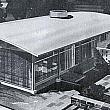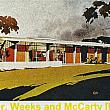Who Was Involved in the Homestyle Center?
by Richard Vettese
The Homestyle project was conceived by Detroit realtor Jason L. Honigman and was eventually promoted by a young University of Michigan trained architect Arleigh “Bud” C. Hitchcock from 1954 through its eventual end in 1957. It was believed that the project would result in various manufacturers wanting to set up experimental centers in Grand Rapids leading eventually to the development of architectural schools drawing students from all over the world.
The Home Research Foundation was founded in 1954 by Mr. Honigman, whose dream of coordinated and integrated home research led to the birth of the project and the Foundation. Mr. Honigman was Vice-President of the Market Realty Company, which had purchased the Pantlind Hotel a few years earlier.
Other original Trustees of the Foundation included Kenneth C. Welch, a nationally known architectural design consultant, Arleigh C. Hitchcock, an architect and sales manager for the Herman Miller Furniture Company, George A. Welch, and Don L. Short. A local advisory committee included John M. Brower, Charles R. Sligh, James P. Erdman, Ward Blackall, Richard Brooks, Don Cederlund, Wesley Aves, Ted Corson, Paul Goebel, and George W. Welsh. Mr. Erdman, who was the Design Coordinator for the Grand Rapids Furniture Makers Guild, would coordinate the interior decoration of all the homes.
On a national scale, many groups such as the National Association of Home Builders, the American Institute of Architects, the American Society of Landscape Architects, and the American Institute of Design all cooperated with the project.
After a period of initial study, Mr. Honigman came to the conclusion that instead of six to eight display homes he originally had in mind, the project would be broadened to encompass the entire housing field, and he increased the number of display homes to fifty. Arleigh Hitchcock, the Foundation Executive Director, completed a nation-wide evaluation for the Homestyle Center, and he developed a prospectus embracing all phases of home building and furnishing. By 1956, the Design and Standards Committee had completed all the preparatory work on twelve home designs to be included in the Homestyle Center, with an additional thirteen homes to be included in 1957 in the Project. The second group of twenty-five homes was to be built in equal numbers during the next three years with the Center complete by 1960. James Robert Smith of Grosse Pointe Farms completed a scale model of the Homestyle Center and its first group of 25 homes working from the initial renderings of the architects. Hitchcock was able to use this model as he tried to raise funds for the Project in 1956 and 1957.
The architects or firms considered for this first group included R. Buckminster Fuller of Geodesics Inc. in North Carolina, Kazumi Adachi of Los Angeles, Alden Dow of Midland, Harwell H. Harris of Fort Worth, Jones & Emmons of Los Angeles, Robert Little of Cleveland, George Nelson of New York, Eliot Noyes of Connecticut, Painter, Weeks and McCarty of Knoxville, Ralph Rapson of Minneapolis, Paul Rudolph of Massachusetts, Royal Barry Wills of Boston, Wurster Bernardi & Emmons of San Francisco, Clifford B. Wright of Detroit, and Zema & Bumgardner of Seattle.

 facebook
facebook

